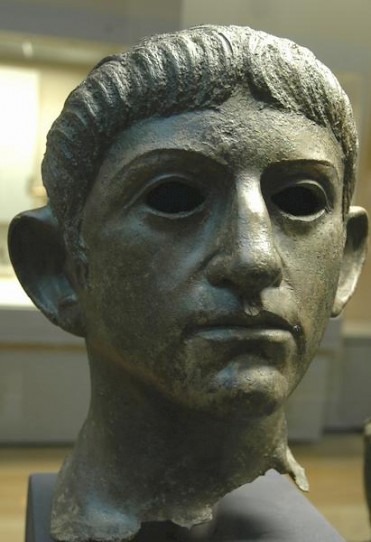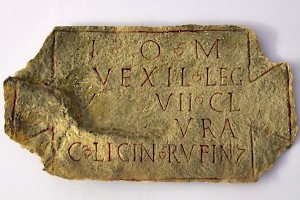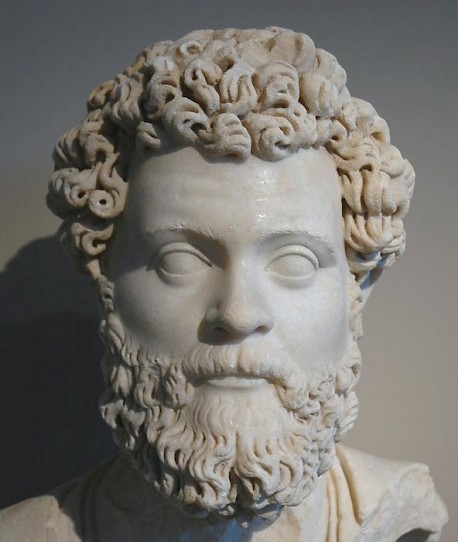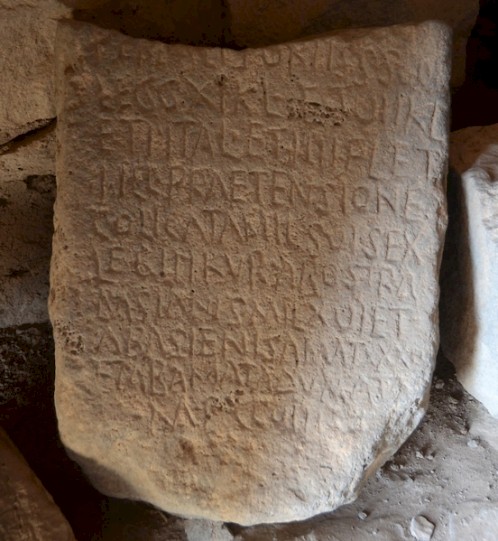Legio VII Claudia Pia Fidelis
Legio VII Claudia Pia Fidelis: one of the Roman legions. Its name means "the legion that is loyal and faithful to Claudius".

With the Eighth, Ninth and Tenth legions, the Seventh was among the oldest units in the imperial Roman army. They were with Julius Caesar when he invaded Gaul in 58 BCE. The Roman commander mentions the Seventh in his account of the battle against the Nervians (57), and it seems that it was employed during the expedition through western Gaul led by Caesar's deputy Crassus. In 56, the Seventh was present during the Venetic campaign, and it later took part in the two expeditions to Britain (55 and 54). During the crisis caused by Vercingetorix, it fought in the neighborhood of Lutetia (52); it must have been active at Alesia and it was certainly involved in the mopping-up operations among the Bellovaci (51).
During the civil war against Caesar's fellow-triumvir and Pompey, the seventh legion fought in Hispania in the battle of Ilerda (summer 49). In the spring of 48, it served at Dyrrhachium. The Seventh was also present in the battle of Pharsalus (9 August 48). After this battle, the soldiers were sent back to Italy to be pensioned off, but in 46, they participated in Caesar's African campaign and fought at Thapsacus.
Next year, the veterans received land near Capua and Luca, but in 44, when the dictator had been killed, many of them joined Octavian, who reconstituted this legion in the autumn (together with the eighth legion) and used it to obtain a position of influence in the winter. Perhaps this explains the old surname of the legion, Paterna, which can be translated as "the old one". It fought at Modena in 43, and at Philippi in 42, after which it returned to Italy with Octavian, who used this unit during the siege of Perugia in 41.
In 36, veterans were settled in southern Gaul. The legion was probably active during Octavian's wars against Sextus Pompeius, who had occupied Sicily, and may have been present when Octavian clashed with Mark Antony at Actium (31). Later, veterans were settled in Mauretania as well.

Octavian became the first emperor of Rome, and seems to have transferred the Seventh Legion to Galatia, although a stay at the Balkans is perhaps just as likely. After all, it was often called Macedonica. (It is also possible that the unit was already called Macedonica after the battle of Philippi in 42 BCE.) In the confused years of the Pannonian insurrection (6-9 CE) or after the battle in the Teutoburg Forest (September 9 CE), it was again moved, this time to Tilurium in Dalmatia, a province occupied together with the Eleventh Legion. (Probably, the two legions shared the fortress at Burnum, modern Kistanje, too.) Several inscriptions attest to the settlement of border disputes between Dalmatian towns by officers of the Seventh Legion.
It was still in Dalmatia was when in 42 the governor of this province, Lucius Arruntius Camillus Scribonianus, revolted against Claudius, who had recently become power. The soldiers of the seventh and eleventh legions, however, quickly put an end to the rebellion. The Seventh, which had been called Paterna or Macedonica until then, received the honorary title Claudia Pia Fidelis, "the seventh Claudian legion, loyal and faithful". The same title was given to the Eleventh.
When IIII Scythica was transferred from the Middle Danube to the Euphrates to fight in Corbulo's eastern campaigns (c.58), VII Claudia Pia Fidelis replaced it. The exact site of its new base is not known but may have been Viminacium, modern Kostolac east of Belgrade, where the unit certainly was staying at a later time.
 Bijaci, Tombstone of Vegnonius of VII Claudia |
 Tilurium, Tombstone of Longinus of VII Claudia |
 Tilurium, Tombstone of Marcius of VII Claudia |
 Tilurium, Tombstone of Vibius of VII Claudia |
During the civil wars after the forced suicide of the emperor Nero in 68, the legion first sided with Otho. A large subunit was sent to fight against the new emperor's rival Vitellius at Cremona, but it could not prevent the latter's victory - the soldiers arrived too late for the battle. Vitellius, however, did not punish the legionaries and sent them back to the Danube. They now started to sympathize with another claimant, Vespasian, who commanded the armies of the east. The Seventh hurried - against Vespasian's orders - to the west again and was among the victors after the second battle of Cremona (69). Vespasian owed his throne to the seventh Claudian legion.

In the second century, its base was Viminacium in Moesia Superior. It is possible that it briefly shared this base with IIII Flavia Felix after 86. In that year, the Dacians had invaded the Roman empire and defeated the legions that were supposed to defend the province of Moesia, which is the area along the south bank of the Danube.
In 88, a large Roman army group invaded Dacia and general Tettius defeated its king Decebalus at Tapae; the Seventh was one of nine legions involved. Unfortunately, the revolt of the governor of Germania Superior, Lucius Antonius Saturninus, in 89, prevented the ultimate Roman victory.

During the reign of Trajan, the war against the Dacians was renewed (101) and the seventh legion was one of the most important units. Its base Viminacium was used to build op the Roman army that was to invade Dacia in the second campaign season (102). In the neighborhood, at Drobeta, the Romans erected a famous bridge across the Danube, designed by Apollodorus of Damascus. It is very likely that soldiers of the seventh legion were employed to do the actual building. Victory was finally achieved in 106.
In 116, the Jews in the eastern provinces of the Roman empire revolted, being inspired by a messianic claimant named Lukuas. Trajan sent the Seventh Legion to Cyprus, where the soldiers restored order. It is not clear from which place the Seventh was sent to Cyprus, but it was probably from Mesopotamia, where Trajan was fighting a war against the Parthian Empire, which ended in disaster.
The eastern campaign of Trajan was repeated, with more success, in the 160s, when Lucius Verus waged war against Parthia. When the Seventh returned from the east, the northern frontier was reorganized, because several tribes, like the Marcomanni, Sarmatians and Quadi, had become restless. Lucius Verus' brother, the emperor Marcus Aurelius, spent ten years fighting on the Middle Danube. It was a difficult war, especially because the Romans suffered from the effects of a plague. In 169, twice the normal annual intake of recruits was needed to keep VII Claudia at full strength. (An inscription mentions that 240 of them were demobilized in 195.)
When the Romans seemed successful and the emperor was ready to create new provinces north of the Danube, a false report that he had died provoked a rebellion in the east, where Avidius Cassius was made emperor (175). Although the usurper was immediately assassinated, Marcus decided to visit the eastern provinces. The fighting on the Danube was interrupted, and the plans to create a new province were never executed. The northern war flared up again in 178-180, the Romans having the upper hand. The details remain obscure, but it is likely that VII Claudia played an important role. The fighting ended with the death of Marcus Aurelius; his son and successor Commodus concluded a very advantageous peace treaty, and the region remained quiet for a long time.
Stray finds prove that soldiers of the Seventh were employed outside Viminacium as well. Several of them served at the headquarters of the governor of Moesia Superior; others occupied forts on the north bank of the Danube, even as late as the mid-third century.

When the governor of Pannonia Superior, Lucius Septimius Severus, was proclaimed emperor in 193, the seventh legion immediately joined his cause. In a lightning campaign the new ruler marched on Rome, where he defeated Didius Julianus (the emperor recognized by the Senate) and became sole ruler of the Roman empire. A subunit of the Seventh may have been present. Later, the same subunit must have played a role in Severus' campaign against his eastern rival Pescennius Niger. It is also likely that the soldiers took part in Severus' campaigns against the Parthian empire, which culminated in the sack of Ctesiphon (198).
Severus was succeeded by his son Caracalla, who again fought a war against the Parthians (216-217). Other emperors fighting in the east, where the Sasanian Persians replaced the Parthians, were Severus Alexander (r.231-233) and Gordian III (r.243-244). Several inscriptions from the east mention the presence of a soldiers of VII Claudia, but we cannot establish to which of these campaigns they belong.

In the third quarter of the third century, the Roman empire was threatened from several sides. The territories north of the Danube had to be evacuated, and there were army revolts. The Seventh may have supported or suppressed Pacatian, an usurper in Viminacium in 248. Several defeats are recorded, and the seventh legion must have suffered. On the other hand, it must have been among the troops that defeated the Visigoths in 269.
During the conflict between the emperor Gallienus and his rival Postumus, the seventh legion supported the first-mentioned, for which it was rewarded with surnames like Pia VI Fidelis VI ("six times faithful and loyal") and Pia VII Fidelis VII. It is not know when it received the surnames that Pia II Fidelis II to Pia V Fidelis V.
In 273, soldiers of this unit (and four other legions) were involved in road building activity in Jordan, as is attested in an inscription from Qasr el-Azraq. This eastern trip may have been exceptional, though. The Seventh was still guarding the Middle Danube at the end of the fourth century. Like almost all Caesarian legions, the emblem of this legion was a bull. The lion is also attested.
 Salona, Tombstone of Trebonius of VII Claudia |
 Salona, Tombstone of Vatinius of VII Claudia |
 Pula, Dedication to T. Settidius |
 Beirut, Tombstone of Valerius Rufus of VII Claudia |
Literature
- J.-P. Laporte, "La legio VIIa et la déduction des colonies augustéenees de Césarienne", in: Yann Le Bohec, Les légions de Rome sous le Haut-Empire (2000 Lyon) 555-579
- Y. Le Bohec & C. Wolff, "Legiones Moesiae Superioris", in: Yann Le Bohec, Les légions de Rome sous le Haut-Empire (2000 Lyon) 239-245
- I. Piso, "Les légions dans la province de Dacie", in: Yann Le Bohec, Les légions de Rome sous le Haut-Empire (2000 Lyon) 205-225
- K. Strobel, "Zur Geschichte der Legiones V (Macedonica) und VII (Claudia pia fidelis) in der frühen Kaiserzeit und zur Stellung der Provinz Galatia in der augusteischen Heeresgeschichte", in: Yann Le Bohec, Les légions de Rome sous le Haut-Empire (2000 Lyon) 515-528